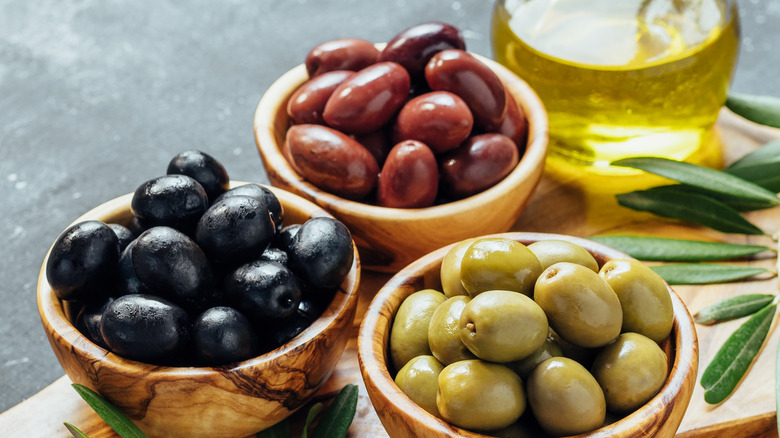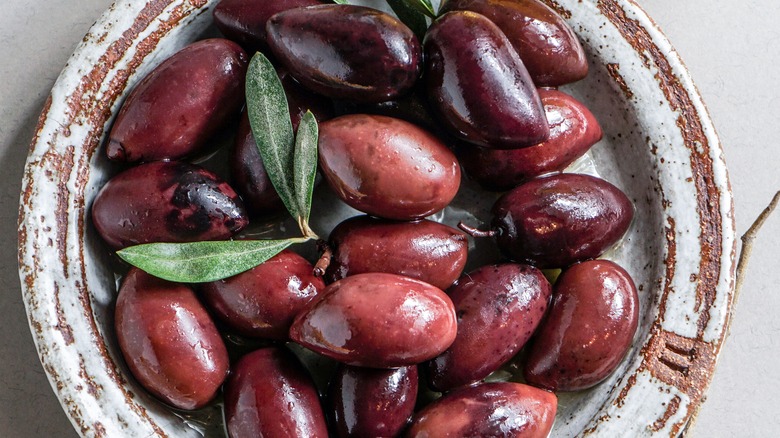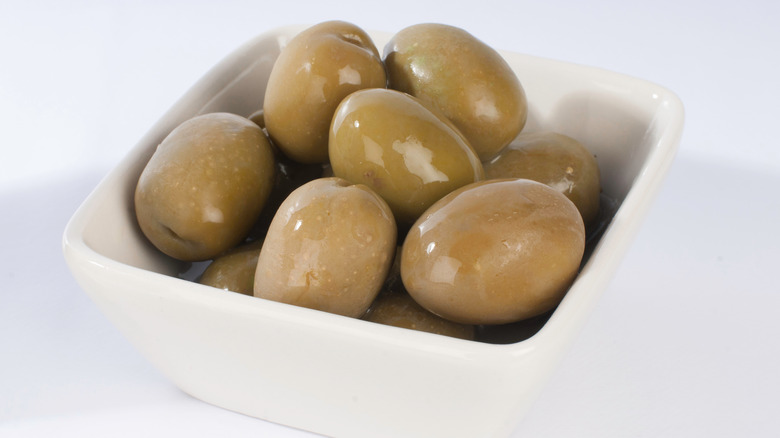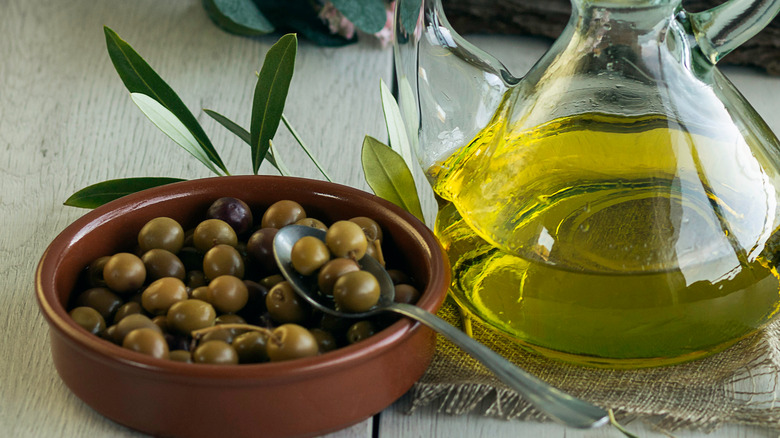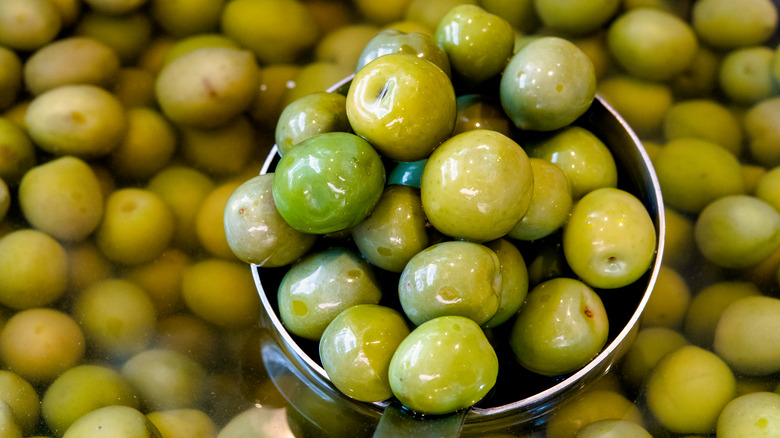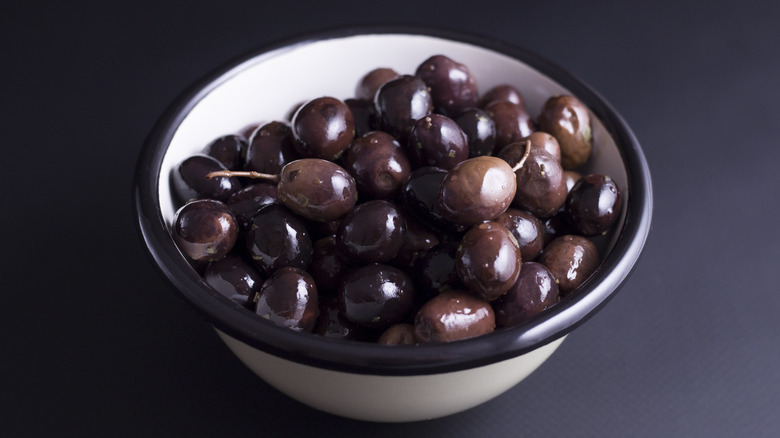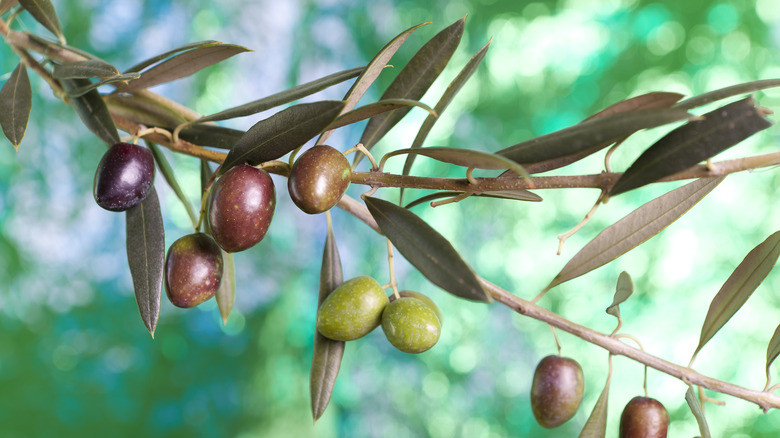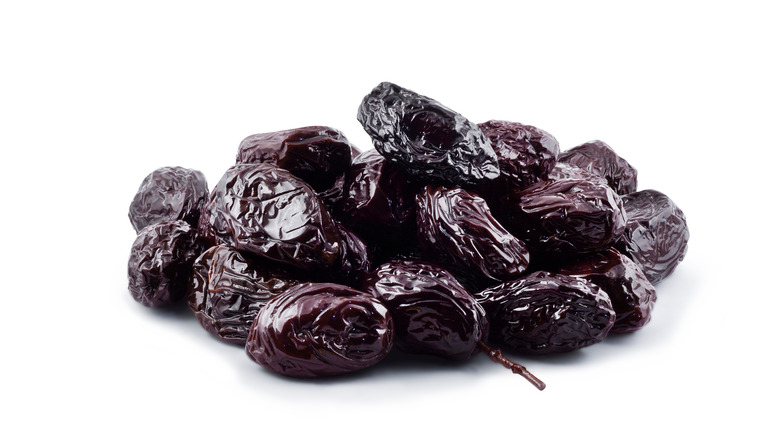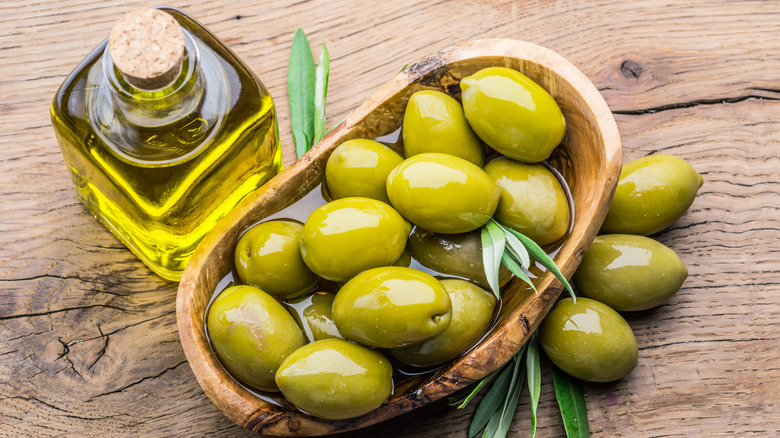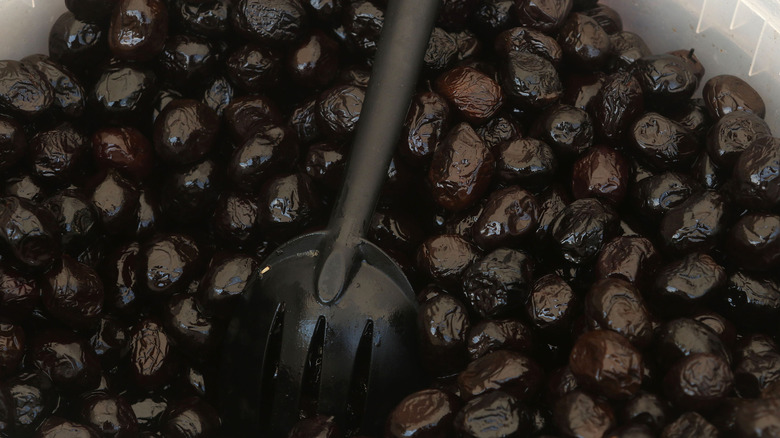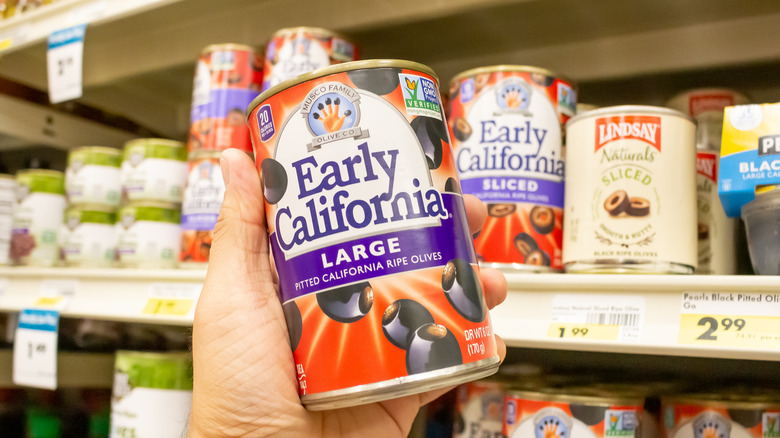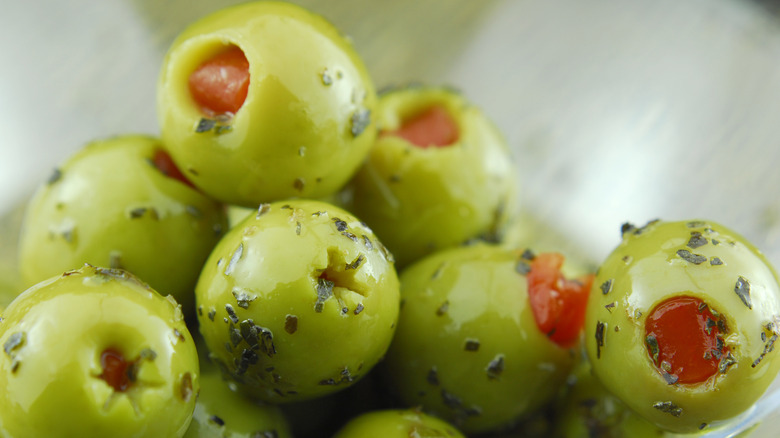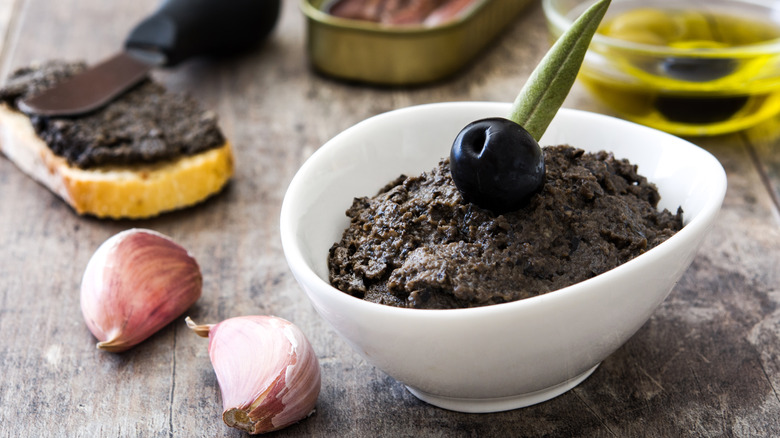12 Most Popular Types Of Olives Explained
Olives are ancient, harkening back to the Bronze Age. According to the World History Encyclopedia, people have cultivated olives for oil in the Middle East since at least 5000 BCE. From there, olive cultivation spread to the rest of the Mediterranean and, eventually, into Europe and the rest of the world. Historically, olives have been used for way more than food. Olive oil has been used for bathing, lighting lamps, and even as medicine. Did you know that using an olive branch as a symbol of peace dates back to ancient Greece?
Olives (Olea Europaea) are technically a drupe, or a fruit with a stone (or pit) in the middle. And while there are many fun ways to eat them, we cannot recommend plucking one straight from the tree and popping it into your mouth. Food Fact says that while raw olives aren't toxic, they are exceptionally bitter and might leave you with a stomachache. So, before olives can be eaten, they must be cured. From sun-drying to pickling to fermentation, different preservation methods are part of what makes various olive cultivars taste unique.
That said, there are some across-the-board ways to tell if your olives have gone bad. If they smell weird or the liquid you're storing them in has gone off, it's best to get rid of them. To keep your olives fresh and tasty, you should keep them in a cool place while submerged in their oil or brine.
Now that you know a bit about olives, let's talk about the most popular types.
Kalamata
These big, dark purple olives are well known outside their homeland of Greece. They're named for a city in the region they come from and fall under the protection of the European Union's designation of origin. That means that many places around the world can only sell the Kalamata cultivar as "kalamata" if it actually comes from that region. Otherwise, the olive is usually sold as a kalamon (via the EU Commission).
Healthline states that kalamata olives are rich in antioxidants, in particular, the polyphenols oleuropein and hydroxytyrosol. These compounds are what make olives taste bitter, but it's also why they may help prevent heart disease and combat cancer. Kalamata olives are also high in oleic acid, a monounsaturated fat connected to lowering bad cholesterol and the risk of heart disease. The thing to watch out for when eating kalamata olives is that they are cured in a salt brine, so they can have a pretty high sodium content.
How should you eat your kalamata olives? They naturally work well in Greek and other Mediterranean dishes. Try a winter Greek salad recipe if you're looking for a spin on the traditional version. If you're craving a main dish, a Mediterranean braised chicken thighs recipe just might do the trick. The lemon, oregano, and olives add a Greek flair to a simple weeknight meal.
Manzanilla
Manzanilla olives (also known as manzanillo) are originally from Sevilla, Spain. You'll find them sold as table olives or used for oil. According to an article by UC Davis, manzanilla were some of the first olives brought to California. During the 18th century, Spanish priests planted them wherever they built missions along the California coast. Manzanillas have been one of the state's most popular cultivars for more than 50 years.
For the best flavor experience, Wisegeek recommends buying manzanillas grown in Australia, California, or Spain. When eaten as table olives, manzanillas are picked and preserved at different points in their maturity, so you can buy them green or black. The greener the olive, the more bitter the taste. The Spanish Olive Oil Interprofessional describes manzanilla oil as having a balanced flavor with undertones of freshly mowed grass, tomatoes, and green apple.
How should you eat these olives? Manzanillas are very commonly stuffed and served as appetizers. If you're looking for something more substantial, try adding them into a gluten-free tagliatelle with braised artichokes, wild mushrooms, and pickled tomatoes recipe. Perhaps you're craving cocina criolla? Well, manzanillas also add a hint of sharpness to arroz con gandules and asopao de pollo, two Puerto Rican foods you have to try at least once.
Arbequina
The arbequina olive is originally from Spain. According to El Mundo, the flavor of the immature olives is similar to that of banana peel or freshly-mowed grass. However, it says ripe arbequinas have hints of fruit puree and vanilla. And while the arbequina is not a very big olive, it definitely packs a flavorful punch.
Mainly used for its oil, arbequina fruits can also be brined and eaten on their own. El Mundo adds that some oils may be a little spicier depending on the region where the arbequina olive is grown. For example, the Texas A&M Agrilife Extension explains that in their state, arbequina olives produce an oil that is sweet with hints of almond.
Arbequina is the most popularly grown olive in California, so you can count on this cultivar being in most of the olive oils produced in the state. This olive oil is so popular it even has an ice cream flavor. While some people have described this frozen treat as bland, others have said the oil lends it a buttery texture. Either way, it is certainly worth trying at least once.
Castelvetrano
From the Valle del Belice in Sicily, castelvetrano olives are picked while green. They are fleshy and unctuous, according to Italian food company DeLallo, and enjoy a protected designation of origin status (via the European Commission). Also known as Nocellara del Belice, these olives are so popular that San Francisco reported a "craze" back in 2009, according to the SF Gate. One store manager went from selling 1,000 pounds in a couple of months to that amount — or more — in one week.
One explanation for this popularity is how much less bitter (some even describe them as "buttery") castelvetrano olives are when compared to other varieties. Castelvetranos don't have to be fermented during the curing process. Instead, they're cured in a water and lye solution. Because these olives are picked before they're ripe, they are crisp, and the flesh won't pull away from the pit easily when you bite into them.
Castelvetranos are excellent as an aperitif since they have a satisfying flavor and bite. You can also try them in your cooking, such as in this calamari with lemon, castelvetrano olives, and bread crumbs recipe. The calamari goes well with olives' mildness.
Niçoise
This cultivar (Olea europaea 'cailletier') has many names, but it's native to the French Riviera and only grows there as the European Union has classified niçoise olive oil made from cailletier cultivars as a product of designated origin.
These are small olives, and they have little flesh when compared to the size of their pit. With that in mind, they can be a bit pricier than your average olive. According to food brand DeLallo, niçoise olives are cured in a sea salt brine, and they are bitter with hints of almonds and hazelnuts.
Though these dark and small olives can be used to make oil, they are probably most famous for their use in salad niçoise, whose assembly has been debated. For what it's worth, the original salad from Nice was a sandwich filled with anchovies, tomatoes, and olive oil. Of course, food evolves. These days, when you say you want a salad niçoise, most U.S. Americans think of lettuce, tuna, anchovies, assorted vegetables, eggs, and of course, olives.
Picual
According to the country's Ministry of Agriculture, picual is Spain's most important olive cultivar. There are currently 210,000 acres of picual orchards in the autonomous community of Andalusia. In fact, Oliaesa, the Artisans of Extra Virgin Olive Oil says that picual olives account for 20% of all the olives in the entire world.
This medium-sized olive is named for its pointy end (pico means "beak" in Spanish). The Olive Oils From Spain describes the green fruit as having a full-body flavor with notes of olive leaf and a subtle bitterness.
While you can certainly eat the olive as a table olive, its oil is what truly shines. Olive Oils From Spain says that picual oils are highly stable and do not oxidize quickly, making them a good choice when cooking. If a trip to Spain isn't in the cards, bring the country to your kitchen — use picual olive oil for both your tortilla española recipe and your garlic aïoli recipe.
Thassos
Thassos olives are notable for many reasons, but perhaps the most unique thing about them is, unlike other olives, you can eat them straight from the tree. But to do that, you'd have to travel to the Greek island of Thassos, which is the only place where this variety of the Throumba olive grows. According to Taste Atlas, the reason that these olives lose their bitterness while still on the tree is thanks to a fungus called Phoma oleae.
Perhaps this is why a study by the Agricultural University of Athens found that Thassos olives have more oleuropein than other olives. What is oleuropein? It is a compound that may play a big part in olive oil's antioxidant powers. While scientists say they need to do more studies, they believe oleuropein could help lower blood pressure.
Even though you can eat them off the tree, Thassos olives are still salt-cured after being picked. Try your Thassos olives as a snack, with pasta, or on a salad. You really can't go wrong.
Picholine
Picholine is a French cultivar, but it represents more than 90% of the olives grown in Morocco. People harvest them green when they want them to be used as table olives. But for oil, growers let them ripen to black. The oil is described as fruity when made from olives harvested earlier in the season; later harvests produce sweeter oils. Unfortunately, there isn't much standardization of practices for growers. So, the nutrient density of picholine olives can vary widely according to researchers from various universities in Morocco.
The light green picholine olive is pointy at both ends and is said to have a slightly lemony flavor. Picholine olives are cured by fermenting them in brine for about a year (via DeLallo) and are excellent on antipasto platters. They are often paired with seafood, but if you're looking to increase your vegetable intake, they would be divine in the pistou of this cauliflower steak recipe. The lemon in the pistou sauce perfectly complements the citrus undertone in the picholine olive.
Beldi
Beldi olives are harvested when very ripe. There are a few different ways to cure these Moroccan olives, but one of the trademarks of a beldi olive is how easily its flesh separates from the pit (partly due to its ripeness). Beldi olives can be sundried, cured in a saltwater brine, or salt-cured dry. They are then usually stored in oil (per Mollie Stones).
Dry salt-curing removes some of the olives' moisture and bitterness. The Michelin Guide explains this process as one where producers massage the olives with salt and then let the fruit air dry for a month before placing them in olive oil to soften them and draw out excess salt. Even still, Beldi is a bitter, chewy olive.
It (and similar olives) are served at breakfast time throughout the Middle East and North Africa. That bitterness means beldi olives pair exceptionally well with slightly sweet foods — try them on pizza, where the fattiness of the cheese and the sweetness of the tomato sauce offsets any bitter notes.
California ripe olives
Technically, California ripe olives don't refer to a single cultivar but rather to large green and black olives of either manzanillo or Sevillano trees. They're water-packed, and you can find them in cans and jars all over the United States. Per The California Olive Committee, the California ripe traces its history back to the mission olives.
Olives grew so well in the California climate that growers had more olives than they could use just for oil. The Ehmann family began the entire California ripe olive industry because their olives weren't big enough to make oil. They learned different curing methods from scientists at UC Berkeley and decided on one that makes the California ripe quite unique.
The curing process involves a mix of lye and water baths that include air bubbles being pumped into the brine. The California Olive Committee says this oxidation is why the olives are black. To keep olives green, they don't add air.
California ripe olives come in many sizes, and you can buy them chopped, sliced, whole, and pitted — they're very versatile. Mild and nutty, these olives are commonly used as pizza toppings and in Tex-Mex dishes such as seven-layer dip.
Stuffed olives
The term "stuffed olives" doesn't refer to a single cultivar or brand. Different olives are used for stuffing, but they're almost always green since unripe olives are sturdier. You can buy them or stuff them yourself. Mental Floss says that in the United States, the pimento-stuffed green olive is perhaps the most well-known.
Pimento peppers are the sweetest peppers out there (they're rated even lower than bell peppers on the Scoville scale). Though they may be popular in the U.S., pimento olives date back to 18th century France, according to USA Today. How do those little pepper pieces get into the olive? Well, it can be done by hand or by machinery. These stuffed olives are a very popular garnish in martinis and as appetizers.
But there is so much more to stuffed olives than pimento. In Spain, you can easily find anchovies in your olives. In Turkey, lemon, orange peel, or almond are common fillers. Closer to home, you can buy garlic-stuffed olives in Gilroy, California, or garlic-and-jalepeño stuffed olives at Trader Joe's (it's said the item will majorly upgrade your charcuterie boards). If you are feeling adventurous, you can always make your own, like this orange-stuffed olives recipe.
Tapenade
Tapenade may sound fancy and intimidating, but it's not. It's simply a paste of olives, capers, anchovies, and occasionally tuna. But don't let its simplicity fool you — those ingredients boast bold flavors, and this spread packs a bold punch. Per Chef Clifford A Wright, this dish likely originated in Provençe. In the Provançal language, tapeno means caper. Old recipes for tapenade included far more caper than they do today, hence the name. Modern versions of the dish are much more olive-forward.
You can buy ready-made tapenade at many price points and in many grocery stores. It's also straightforward to make at home like this vegan tapenade recipe that omits anchovies or capers. While it's not quite traditional, it is tasty and much more accessible — all you need is pitted olives, olive oil, garlic, mustard, and spices. Blend them up in a food processor and serve with chips or on bread.
